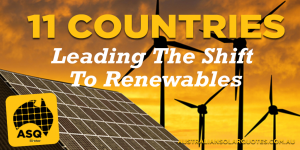In December 2015, close to 200 countries from all around the world signed the COP21 Paris Agreement, henceforth committing to decreasing their share of greenhouse gas emissions… and subsequently putting a stop to global warming.
Many have doubts that this can be done, or are wondering how this can be done.
However, the solution is simple: stop using fossil fuels, and replace them with clean, renewable energy.
Many countries have already made a move towards the shift to renewables and a carbon-friendly future, in a number of various forms.
Whether it’s solar, geothermal or wind power, it’s happening all around the globe. Here are 11 countries that are taking the lead and making healthy investments in renewables.
Costa Rica
By using energy sources such as wind, solar, geothermal, hydroelectric and additional low-carbon energy generation, Costa Rica is powered by a huge 99 per cent renewables. It’s unique geography and environmental protection commitment has made this possible, and by 2021 their goal is to be entirely carbon-neutral.
Sweden
Sweden set an ambitious goal in 2015 to completely do away with all fossil fuel usage in their borders and to increase wind, solar, energy storage, smart grid and clean transport investment. Even better, they are making it competitive. Sweden is challenging the rest of the world to a race in becoming the first fossil fuel-free nation!
Nicaragua
In June last year, renewables comprised of 54 per cent of Nicaragua’s total electricity production. Their shift to renewables started in 2007 when the president at the time started emphasizing investments in renewable energy. Nicaragua then invested the fifth largest percentage in the world of their GDP in developing renewables, in 2012. Next on the agenda: Nicaragua wants to have 90 per cent of their energy needs met by renewables by 2020.
Germany
Germany is the world leader in solar PV capacity; they are sitting at 38.2 gigawatts (in comparison Australia has 4.1 gigawatts) and have met up to 78 per cent of electricity demand in a day with renewable energy. Although they are a quite cloudy country of more then 80 million residents, Germany’s solar power future is bright.
Scotland
Wind power is prominent in Scotland, with 97 per cent of household electricity needs in the country being met with energy generated from wind turbines.
Denmark
Wind turbines provided a huge 42 per cent of Denmark’s electricity in 2015. This is the biggest percentage of wind power met ever before in the world, and they had two of their wind farms offline.
By 2050, Denmark plans to be totally fossil fuel-free and with their impressive wind power generation, they are definitely on the way there.
Uruguay
Proving that the switch to renewable isn’t as hard as it sees, Uruguay is now powered by 95 per cent renewables after less then 10 years of coordinated effort.
They made large investments in solar and wind power without subsidies or consumer taxes, and they credit their success to “Clear decision-making, a supportive regulatory environment, and a strong partnership between the public and private sector,”.
Morocco
The largest concentrated solar plant in the world has recently been switched on in Morocco on the edge of the Sahara desert. Already generating up to 160 megawatts of power, upon completion it will be able to reach a huge 580 megawatts; potentially enough energy to power in excess of one million homes by the year 2018.
China
Although they are also the world’s leader in PRODUCING carbon emissions, in 2014 China had the most wind energy capacity installed by far, and the second-highest solar PV capacity installed.
Eager to change their ways, China has committed to phasing out coal power and cleaning their polluted air.
USA
In 2014 the US came fifth in most installed soalr PV capacity worldwide, with a new solar power system being installed every two minutes and 30 seconds. They also came second to China in most installed wind energy capacity.
Energy demand in the US still outweighs the capacity of renewable currently, however a study estimates that in 15 years emissions could be reduced by almost 80 per cent.
Kenya
2015 saw geothermal energy accounting for 51 per cent of Kenya’s total energy mix- a huge jump from 13 per cent in 2010. Africa’s largest wind farm of 310MW is also ready to provide an addition 20 per cent of the nation’s installed power generation capacity, raising the renewables total to 71 per cent.


